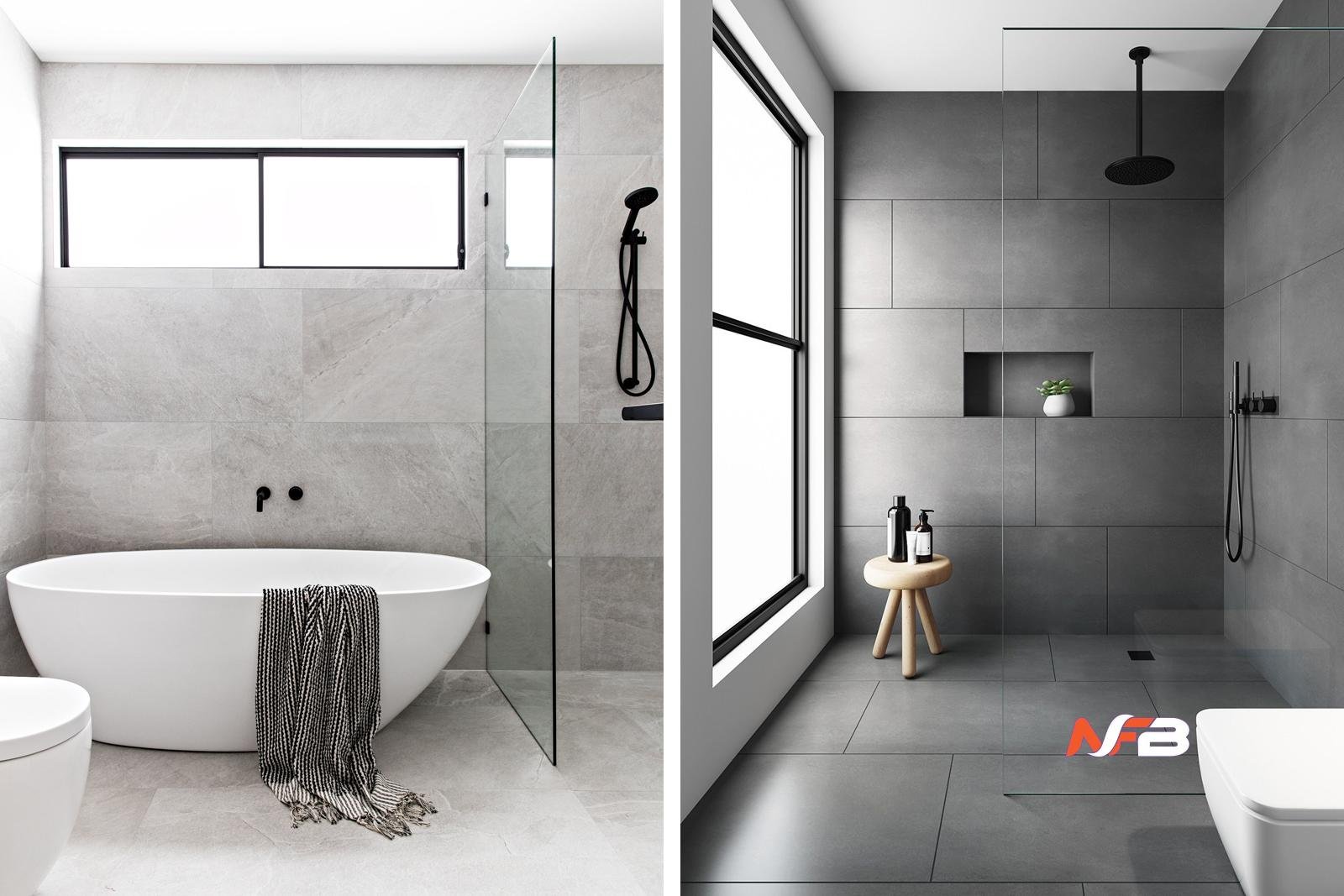Choosing tiles for a bathroom renovation can feel surprisingly complicated. Beyond colours, finishes and patterns, one of the biggest questions is whether to go for small or large tiles. Both options can completely change the look and feel of a bathroom, especially in homes where space is at a premium. What works well in a big family bathroom might not suit a compact en suite, and vice versa. Understanding how tile size affects the design, maintenance and practical feel of a bathroom is key to getting it right.
With more homeowners wanting bathrooms that feel bright, luxurious and easy to clean, the debate between small and large tiles has never been more relevant. Each comes with its own advantages and drawbacks, so it’s worth weighing them up before you start laying out samples on the showroom floor.
The Impact of Tile Size on Space
One of the biggest reasons people lean towards larger tiles is how they can make a space feel bigger. In smaller bathrooms, large-format tiles often create the illusion of more space because there are fewer grout lines breaking up the walls and floors. The eye flows across a more continuous surface, which helps trick the mind into seeing the room as more open.
Small tiles, by contrast, create more visual texture. This can be charming in certain bathrooms, especially period homes or quirky spaces where character matters. Mosaic tiles, metro tiles and small squares can add interest and charm, but in a compact bathroom, too many grout lines can make walls feel busy and the room feel more enclosed.
However, scale also depends on the shape and layout of the room. A very narrow bathroom with low ceilings might feel overwhelmed by huge tiles that have to be cut awkwardly around corners. In that case, slightly smaller tiles or a mix of sizes might look more balanced.
Style and Design Considerations
Small tiles come in a huge variety of styles. From classic Victorian mosaics and intricate patterns to timeless metro tiles that never go out of fashion, they offer plenty of ways to create character. This makes them ideal for homeowners who want a statement feature wall, decorative border or a splashback behind a basin.
Large tiles lean towards a more contemporary feel. They are often chosen for minimalist, spa-inspired bathrooms where sleek, uninterrupted surfaces feel calming and modern. Plain large tiles in natural stone or neutral porcelain can look incredibly sophisticated, creating that boutique hotel look that many homeowners love.
A good design trick is to combine both sizes in the same space. For example, you might choose large tiles for the main walls and floor to keep the look clean, then add a section of small tiles in the shower niche or as a border to break up the expanse. This creates a focal point without making the room feel cluttered.
Practical Considerations: Cutting and Installation
The practical side of fitting tiles often comes as a surprise. Large-format tiles are quicker to lay because there are fewer pieces overall, but they do require a flat, even surface. If your walls or floors are not perfectly level, large tiles can highlight imperfections and make installation trickier. Cutting large tiles accurately around fixtures and fittings can also be more fiddly and may create more wastage if a mistake is made.
Small tiles are easier to fit into awkward nooks and crannies. They tend to be more forgiving of uneven walls because the many grout lines help disguise slight differences. This can be especially handy in older houses where walls are rarely straight. Mosaic sheets are also flexible, making them ideal for curved surfaces or wet rooms with lots of angles.
However, small tiles take longer to install overall because there are more pieces to line up. This can add to labour costs, so it’s worth considering your budget as well as your preferred look.
Cleaning and Maintenance
Cleaning is another area where tile size matters more than you might think. Large tiles have fewer grout lines, which means there are fewer places for dirt, mould and limescale to build up. This makes them easier to keep clean, particularly in high-moisture areas like showers and wet rooms.
Small tiles, especially mosaics or patterned layouts, have more grout joints, and grout can be notorious for staining or discolouring over time. Proper sealing and regular cleaning can help keep small tiles looking fresh, but they do require more maintenance. If you’re someone who wants a low-fuss bathroom that stays looking good with minimal effort, large tiles could save you time and hassle.
That said, not all grout is created equal. Newer, high-performance grouts are designed to resist mould and staining better than older products. Choosing the right grout colour can also make a big difference — darker grout can hide marks, while white grout often needs more frequent scrubbing.
Cost Factors to Keep in Mind
At first glance, large tiles can seem more expensive per tile than smaller ones, but the total cost of tiling a bathroom depends on several factors. Large tiles often cover more area with fewer pieces, which can reduce labour time. However, because they require more precise handling, you may pay a premium for skilled installation.
Small tiles can cost less per square metre, but the extra labour involved in setting out, cutting and grouting can add up. Mosaics or intricate patterns can be especially time-consuming to get right, so they may end up costing more than expected.
Your choice should balance your budget with the overall effect you want to achieve. A simple large tile layout with minimal cuts might save money, while a decorative scheme with hand-cut small tiles will usually need a bigger budget and a good installer to get the details right.
Matching Tile Size to Bathroom Fixtures
The scale of your bathroom fixtures and fittings should also influence your choice. In a small cloakroom or en suite with a compact basin and slim shower, massive tiles might feel out of proportion, especially if they have to be cut into lots of awkward shapes to fit. In these cases, mid-sized or small tiles often feel more balanced.
In larger family bathrooms or master en suites with bigger baths, wide shower enclosures or double sinks, large tiles tend to complement the sense of space. When walls and floors line up nicely with fewer cuts, the finish looks neater and more expensive.
Some homeowners choose to tile the bath panel, cistern box or built-in shelving in a smaller tile to break up the surfaces while keeping the main walls and floor in large tiles. This mix can add depth and interest without creating a patchwork effect.
Light and Colour: Getting the Best From Your Tiles
Tile size can also influence how light bounces around the room. Large glossy tiles reflect more light because they have bigger uninterrupted surfaces, which can help brighten a dark or windowless bathroom. Pale-coloured large tiles with minimal grout lines work especially well in basements or north-facing rooms where natural light is limited.
Small tiles with a glossy finish can also help reflect light, but the extra grout lines can sometimes break up the effect. In bathrooms where you want to create a cosy, intimate atmosphere, small tiles in warm or dark shades can make the space feel snug and inviting.
Matte finishes have grown in popularity in recent years, especially for large tiles in modern bathrooms. They offer a softer, more natural look, but they do tend to absorb light rather than reflect it. Combining matte and gloss finishes in clever ways can help balance light levels while still keeping the look fresh.
Thinking About Future-Proofing
Bathrooms are one of the rooms people are least likely to renovate frequently, so it’s worth thinking about how your tile choice will age over time. Large-format tiles in neutral shades often have a timeless appeal that works well if you plan to sell your home in a few years. They create a blank canvas that buyers can dress up with accessories, which can help make your property more attractive.
Small tiles can be timeless too, especially classic choices like metro tiles or Victorian mosaics that suit period properties. However, bold patterned small tiles can date quickly if you’re following a strong trend. If you love a pop of pattern but want to keep things flexible, consider using bolder small tiles in areas that can be changed easily, like splashbacks or niches, rather than on every wall.
Finding the Right Balance
Choosing between small and large tiles doesn’t always have to be an either-or decision. Many of the most striking bathroom designs use a mix of tile sizes and shapes to create contrast and highlight different areas of the room.
An experienced bathroom designer or tiler can help you play with scale, layout and finishes to make the space feel balanced and practical. For some homeowners, large tiles make sense for the main surfaces, with small tiles adding accents and detail. For others, a consistent tile size throughout keeps things calm and cohesive.
What matters most is how your choice works with the shape, size and feel of your bathroom — and how much time you’re willing to spend on cleaning and maintenance once your dream bathroom is complete.














Leave a Reply